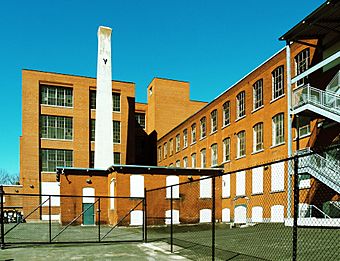- This page was last modified on 17 October 2025, at 10:18. Suggest an edit.
Cluett Peabody & Company facts for kids
|
Cluett Peabody & Company, Inc.
|
|
 |
|
| Location | Leominster, Massachusetts |
|---|---|
| Built | 1902 |
| Architectural style | Colonial Revival |
| NRHP reference No. | 89000439 |
| Added to NRHP | June 8, 1989 |
Cluett Peabody & Company, Inc. was a famous company that made shirts, collars, and other clothes for a long time. It was once based in Troy, New York. The company was best known for its "Arrow" brand collars and shirts. You might have seen pictures of the "Arrow Collar Man" from their old advertisements (1905–1931).
This company started way back in the mid-1800s, though it had a different name then. It later became part of another company called Westpoint Pepperell in the 1980s. Today, the "Arrow" name is still used for men's shirts and ties.
Cluett Peabody made shirts and collars in a special old building. This building is located at 123 First Street in Leominster, Massachusetts. It was built in 1902. In 1989, it was added to the National Register of Historic Places. This means it's an important historical site.
Contents
The Story of Cluett Peabody
The Arrow shirt company was first started by William H. Titus and his partner in Chicago, Illinois. Later, in the late 1800s, it joined with Cluett Peabody. At the time they merged, both companies were making about $20 million in sales each year. William Titus and his partner later became leaders of the new combined company.
How the Company Began
The story of Cluett Peabody goes back to 1851. A company called Maullin & Blanchard started making collars in Troy, New York. Over the years, the company changed names a few times. In 1861, a clerk named George B. Cluett became a partner.
After some changes, George B. Cluett and Joseph Maullin formed a new company. When Mr. Maullin passed away in 1863, the company became Geo. B. Cluett, Bros., & Co.
Joining Forces: Cluett, Coon & Co.
In 1891, Geo. B. Cluett, Bros., & Co. joined with another company from Troy, NY, called Coon & Co. This new company was named Cluett, Coon & Co. Frederick F. Peabody also joined the firm at this time.
Soon after, in 1899, Cluett, Coon & Co. changed its name to Cluett, Peabody & Co. This is the name it became famous for.
From Collars to Shirts
Before 1919, Cluett, Peabody & Co. mainly made men's shirt collars. But in the 1920s, people started wanting shirts with collars already attached. The demand for separate collars went down.
So, in 1929, Cluett, Peabody & Co. started selling men's clothing across the country. They used the "Arrow" brand name. The "Arrow" brand grew to include many products. These included shirts, handkerchiefs, ties, pajamas, and underwear for men and boys.
Growth and Production
By 1935, Cluett Peabody had eleven factories. Most of these were in the northeastern United States. One of these factories was the building in Leominster, Massachusetts.
The company grew a lot. In 1945, their sales were $31.3 million. By 1955, sales had almost tripled to $87.4 million. At their busiest time, they owned 13 factories. They also had two more factories in a company they fully owned.
Each week, they made about 67,700 dozen items. That's a lot of shirts and collars! In the mid-1970s, they also worked with other companies to make even more items. This brought their total weekly production to almost 98,700 dozen. They even started getting shirts made in Korea.
Changes in Ownership
Cluett, Peabody & Co. was bought by WestPoint Pepperell, Inc. in 1985. Then, in 1990, another company called Bidermann Industries bought Cluett, Peabody & Co. from WestPoint Pepperell.
Later, in 1998, Cluett American Group bought the company. In 2004, Phillips-Van Heusen Corporation bought the "Arrow" brand name. They also bought the business that handles licensing for the brand.
The rest of the Cluett American Group now operates as Gold Toe Brands. This company still owns the rights to the "Sanforization" process. This is a special way to pre-shrink fabric. It was invented by Sanford L. Cluett, who joined Cluett, Peabody & Co. in 1919.


